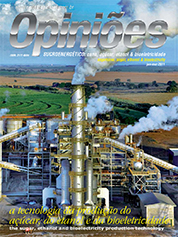Dimas Alfredo Barro
President of Fermentec
Op-AA-27
Progress of fermentation
Alcoholic fermentation has been known to mankind for at least 15,000 years. It consists of the transformation of sugar into ethanol by microorganisms, of which the main one is yeast. A British scientist discovered traces of alcohol in kitchen utensils found in archaeological sites dating back to more than 15,000 years.
He has sustained the theory that human beings, prior to the introduction of agriculture, already fermented fruit and roots. To make an alcoholic beverage is not difficult, but if the objective is to obtain a uniform quality product, then this is a different issue. The fermentation of sugarcane juice was accomplished with yeast or ferment that already existed in sugarcane juice or in fermentation vessels. Since the lineage of such yeast was not controlled, the quality varied greatly.
Improvements to fermentation in Brazil came with the French, at the beginning of the past century, when separator centrifuges to recycle yeast were introduced, At that time, fermentation was mostly done using molasses that, after being diluted, made up the must that was then fermented. Fermentation yield was at about 70-75% in relation to the theoretical reference (100%), and fermentation took from 16 to 20 hours.
Alcohol content at the end of the fermentation did not exceed 6-7%. Thus, the production of vinasse per liter of alcohol was high, of about 16 to 18 liters of vinasse per liter of alcohol produced. With the beginning of the National Alcohol Program in 1975, the volume produced per unit increased considerably, given that previously the fermenters had capacities of 50,000 and 100,000 liters and now were designed for holding 200,000, 400,000, 500,000 and 1 million liters, with present day capacities of up to 3.5 million liters each.
With the increase in production, along came innovations. In the first 10 years, development was impressive, with fermentation yields increasing from 70-75% to 85%. Fermentation time was reduced to 10 hours, which initially caused overheating problems that were subsequently resolved.
In the early eighties, attempts were made to change the fermentation process from batch-based to continuous fermentation, seeking to attain savings in initial investments due to the reduction in idle time spent to fill and empty the fermentation vessels or fermenters. Savings also resulted from using less heat exchangers.
Initial attempts were pretty much unsuccessful, given that contamination by bacteria was so serious that yield and fermentation time were affected to a very high degree, causing huge losses. In the nineties, this process was improved with more appropriate designs and projects, so that the novelties were widely accepted, with many units having been converted from batch fermentation to the continuous modality, resulting in that 25% of the distilleries in Brazil opted for the process.
However, ten years later, due to serious contamination problems through bacteria and yeast, many units switched back to the batch modality, so that nowadays about 15% of the units use the continuous process. For the most part, new distilleries adopt the batch system. In the United States, a similar fact occurred, given that in the beginning of the American ethanol program, in the eighties, about 70% of the ethanol was produced by continuous fermentation, and in the last five years, a time when the USA surpassed Brazil in production, no new distillery opted for the continuous process. The problem was the same: contamination.
To produce ethanol is to make money, and this must be seen in an overall perspective of a production unit, i.e., by industry and agriculture. Apart from high yield, which is economically essential because raw material accounts for more than 70% of ethanol’s cost, there are other relevant parameters. To achieve high yield, in the fermenters one must use yeast that does not produce much foam, does not flocculate excessively, has an adequate fermentation time in relation to production and leaves little residual sugar.
How to accomplish such a feat? By using adequate yeast in one’s distillery. Nowadays, the best distilleries are able to operate with bacterial contamination levels of 106, with low input levels and yields in excess of 90%. Until a short while ago, vinasse volume was no problem, given the possibility of “ferti-irrigation”, which is highly recommended in regions of scarce hydric resources.
However, with this new legislation, no longer may one add potassium and all other salts inherent to vinasse above certain levels and mainly in regions where it rains even in harvest times. It has become unprofitable to transport this vinasse over great distances. An alternative is to concentrate vinasse, which requires considerable investment and high expenses with vapor.
The most promising, depending on the case, would be to associate the concentration of vinasse and fermentation with high alcohol content. Alcohol fermentations producing wine with more than 10% of alcohol content were very slow, yeast died and the yield ended up decreasing too.
However, based on research conducted by Fermentec on a pilot scale, it was possible to develop a batch process in the last five years, in which one can attain wines with 16% alcohol content, and that reduces vinasse volume by half. Apart from the decrease in vapor volume used to produce a liter of ethanol, we will be able to significantly reduce the cost of distributing vinasse. Depending on the case, the system pays off in a period of three to four years.
In order to bring this innovation to market, Fermentec associated with Dedini, that assumed responsibility for the energy balance calculations and the construction of the chiller to keep the fermenters at the right temperature. It is the first time in the world that one has been able to ferment with 16-17% alcohol content in 17 hours, with yeast recycling. In the USA, one operates with up to 18%, but fermentation time is between 55 and 70 hours. This technological advancement will keep Brazil in the lead as concerning the alcohol fermentation process, with substrata readily metabolized by yeast.




